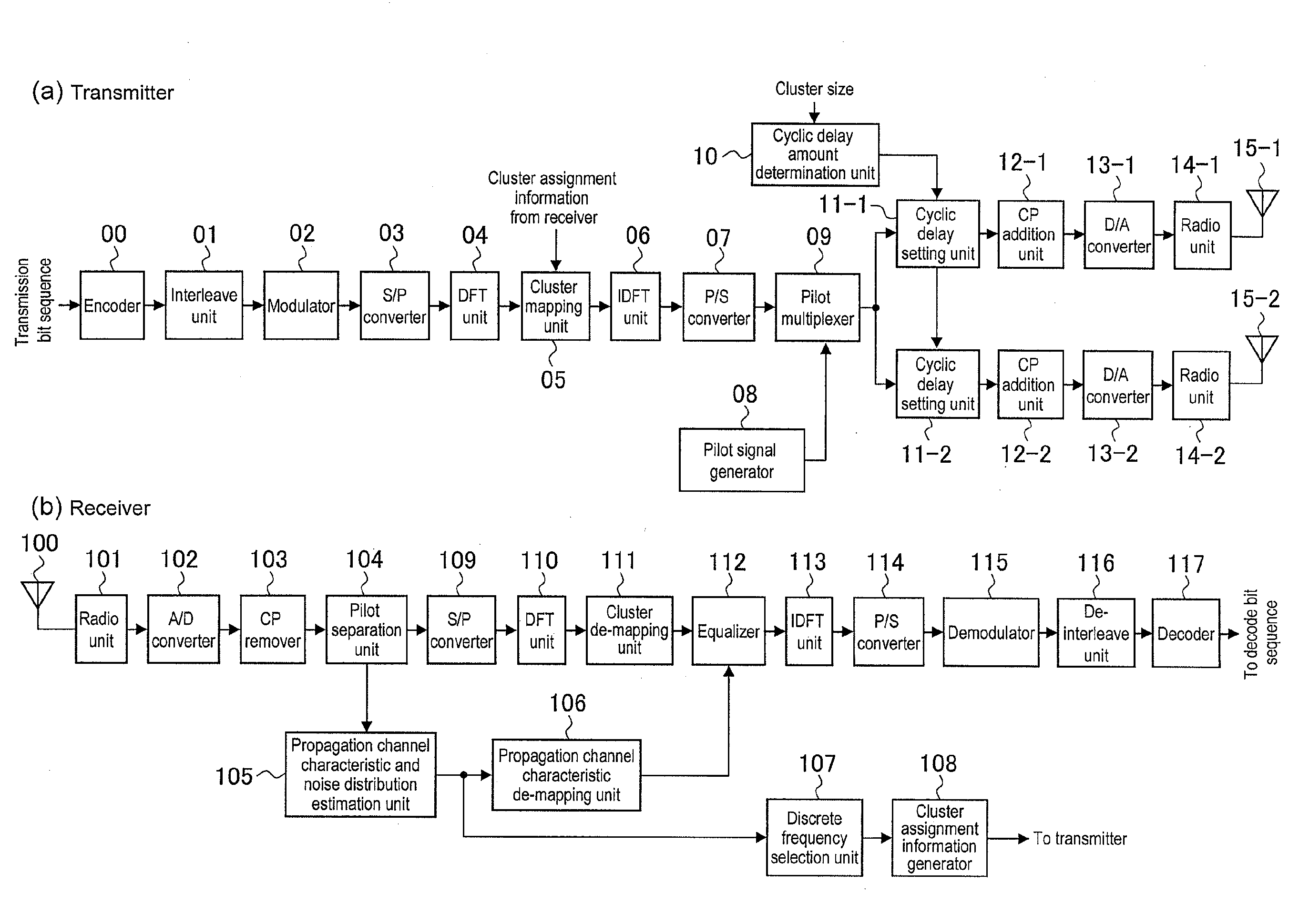Wireless communication system, transmitter and receiver
a communication system and transmitter technology, applied in the field of wireless communication technology, can solve the problems of high papr (peak to average power ratio), extremely large trouble in uplink where amplifiers have limitations, etc., and achieve the effect of improving throughput, increasing frequency selectivity, and reducing the error rate of signals
- Summary
- Abstract
- Description
- Claims
- Application Information
AI Technical Summary
Benefits of technology
Problems solved by technology
Method used
Image
Examples
first embodiment
[0031]In a first embodiment of the present invention, a description will be given of a technique using a method for setting an appropriate CDD delay amount when a cluster size (the number of subcarriers to be included in a single cluster) is determined. Here, the description will be given of an example using two transmission antennas for the sake of simplicity of the description. In addition, the cluster size will be described on the assumption that an appropriate value of the cluster size is already determined between a transmitter and a receiver will be described.
[0032]Normally, the cluster size is determined on the basis of a difference between a characteristic of a power amplifier and a transmission power (referred to as a “power headroom” or the like in some cases) in a transmitter. The PAPR property becomes worse as the cluster size is set smaller. Conversely, the PAPR property becomes closer to a PAPR property of a single carrier scheme as the cluster size is set larger. Acco...
second embodiment
[0044]Next, a communication technique according to a second embodiment of the present invention will be described with reference to the drawings. The communication technique according to this embodiment assumes a case where a temporal propagation channel fluctuation occurs drastically, such as a case where a terminal device moves fast. In this case, even if a propagation channel estimation is made by the receiver and then is fed back to the transmitter, the propagation channel characteristic is likely to change when the transmission using the information is performed. As a result, the cluster assignment performed with the propagation characteristic taken into consideration is not effective in this case.
[0045]In this respect, frequency diversity that is high on average no matter which band the assignment is performed on regardless of the propagation channel characteristic is preferred in a situation where a terminal device moves fast.
[0046]Here, with reference to FIG. 3, a descriptio...
third embodiment
[0050]The first and second embodiments are shown as the case where the number of transmission antennas is determined to be two. In this embodiment, however, an example in which N (>2) transmission antennas are used will be described. To begin with, consideration is given to a case where, as described in the first embodiment, a cyclic delay amount is set such that a cluster is assigned to only a frequency having a good characteristic with the cluster size matched with the cycle of the frequency selectivity of the propagation channel characteristic.
[0051]Frequency rotation φi(n) given by the n-th (1
[Equation4]φi(n)=exp(-j·2πNFFT·δn·i)(4)
[0052]δn is a value determined for each antenna. A condition required for δn is that the fluctuation cycle of the frequency response of the propagation channel expected to occur in the receiver is at least twice the cluster size (the value is set to be twice the cluster size in the first embodiment). A...
PUM
 Login to View More
Login to View More Abstract
Description
Claims
Application Information
 Login to View More
Login to View More - R&D
- Intellectual Property
- Life Sciences
- Materials
- Tech Scout
- Unparalleled Data Quality
- Higher Quality Content
- 60% Fewer Hallucinations
Browse by: Latest US Patents, China's latest patents, Technical Efficacy Thesaurus, Application Domain, Technology Topic, Popular Technical Reports.
© 2025 PatSnap. All rights reserved.Legal|Privacy policy|Modern Slavery Act Transparency Statement|Sitemap|About US| Contact US: help@patsnap.com



